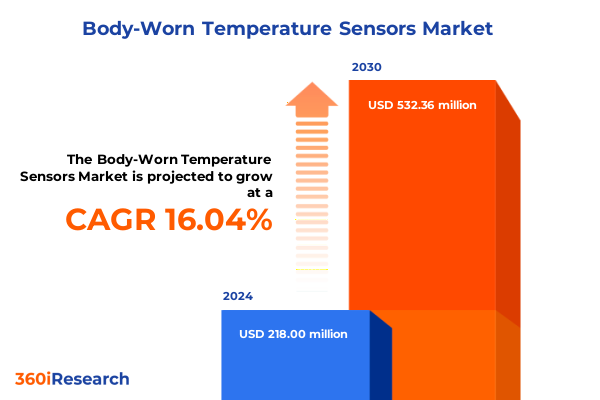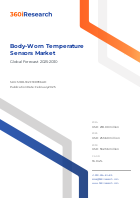The Body-Worn Temperature Sensors Market size was estimated at USD 218.00 million in 2024 and expected to reach USD 253.60 million in 2025, at a CAGR 16.04% to reach USD 532.36 million by 2030.

Executive Summary: Body-Worn Temperature Sensors Landscape Overview
Wearable temperature monitoring technologies are redefining how individuals and organizations track physiological data in real time. Combining miniaturized sensors, advanced materials and robust data analytics, body-worn temperature sensors deliver actionable insights across medical, industrial and consumer domains. The increasing demand for continuous health surveillance, elevated workplace safety requirements and heightened interest in performance optimization drive this sector’s rapid evolution. As sensor accuracy, battery life and connectivity improve, stakeholders-from clinicians and safety managers to athletes and parents-are unlocking new use cases that extend far beyond traditional thermometry.
This executive summary distills critical developments shaping the body-worn temperature sensor landscape, offering a concise yet comprehensive overview of transformative shifts, regulatory influences, segmentation dynamics, regional variations and competitive positioning. By synthesizing these factors, industry leaders can identify strategic opportunities, anticipate potential challenges and chart pathways to sustainable growth.
Transformative Shifts Reshaping the Body-Worn Temperature Sensors Market
Rapid technological convergence and evolving user expectations are ushering in a new era for body-worn temperature sensors. First, the integration of artificial intelligence into embedded sensing platforms is shifting the emphasis from raw data capture to intelligent anomaly detection, enabling proactive health alerts rather than retrospective analyses. Second, materials science breakthroughs-particularly in bio-compatible coatings and flexible substrates-are facilitating seamless skin contact, driving higher long-term accuracy during dynamic activities.
Meanwhile, the transition toward cloud-native architectures and edge computing is redefining data management, reducing latency for real-time monitoring and enabling decentralized care models. Enhanced battery management systems combined with wireless power solutions are extending operational lifespans, critical for continuous industrial and military deployments. Lastly, the convergence of passive sensing techniques with active, self-calibrating technologies is empowering multi-modal platforms that can concurrently assess temperature, motion and physiological stress markers. Together, these shifts are expanding the utility of wearable thermometry from episodic checks to comprehensive wellness, safety and performance ecosystems.
Cumulative Impact of United States Tariffs on Temperature Sensor Supply Chains
New tariff structures imposed by the United States in 2025 are exerting notable pressure on global supply chains for precision sensor components and specialized materials. Higher import duties on semiconductor chips, polymer substrates and proprietary coatings have increased procurement costs for sensor manufacturers, prompting many to re-evaluate offshore sourcing strategies. As a result, companies are considering near-shore production, strategic stockpiling and alternative material formulations to mitigate margin erosion.
These tariffs also accelerate vertical integration efforts, as leading firms invest in in-house fabrication capabilities to bypass external cost escalations. For device assemblers, the need to optimize logistics networks has driven partnerships with freight consolidators and specialized customs brokers to streamline cross-border flows. While compliance requirements have grown more complex, manufacturers that adapt through supply chain diversification and agile inventory management stand to maintain competitive pricing and ensure continuity of product delivery.
Key Insights from Application, Product Type, End User, Technology and Functionality Segmentation
A nuanced segmentation framework reveals divergent performance drivers across applications, product types, end users, technologies and functionalities. In healthcare monitoring-where fever detection, patient temperature tracking and post-surgery recovery monitoring dominate-regulatory compliance and clinical validation are paramount, supporting premium pricing structures and extended device lifecycles. Meanwhile, industrial safety applications focused on fatigue management, heat exposure risk assessment and occupational health monitoring prioritize ruggedized designs and long battery endurance, ensuring reliability in demanding environments.
Infant care segments such as fever checks, SIDS prevention and sleep temperature monitoring favor ultra-gentle adhesives and minimal form factors to maximize comfort. Military and defense use cases for mission readiness tracking, soldier health monitoring and temperature stress assessment demand secure data encryption and rapid deployment kits. In sports and fitness-spanning athlete performance monitoring, caloric expenditure tracking and heat stress management-designers balance sensor accuracy with aesthetic integration into apparel.
On the product front, smart clothing platforms featuring embedded and removable sensors are carving out new ecosystems by uniting garments with analytics. Smartwatch-based sensors, available in both integrated systems and standalone models, leverage familiar form factors to accelerate consumer adoption. Wearable patches, whether disposable or rechargeable, offer granular placement flexibility; disposable formats further subdivide into single-use and multiple-use offerings for varying durations. Traditional wearable thermometers employing ear and underarm devices remain relevant for specific clinical and home-care workstreams.
Institutional and individual stakeholders exhibit distinct procurement patterns. Corporate wellness programs emphasizing employee health tracking and occupational safety programs seek scalable subscription models. Hospitals and clinics invest in inpatient monitoring and outpatient care solutions with comprehensive IT integration. Fitness enthusiasts and health-conscious users drive demand among individual consumers, while academic studies and clinical trials conducted by research institutions reinforce evidence-based optimization. Sports teams and coaches, spanning amateur to professional levels, value real-time feedback loops for performance enhancement.
Technological innovation centers on active sensors powered by AI-driven algorithms and self-calibrating systems, supported by advanced data analytics, battery management systems and wireless power solutions. Passive sensors continue to play complementary roles where energy harvesting techniques suffice. Bio-compatible materials such as polyurethane and silicone coatings ensure skin conformity and reduce irritation risks. Finally, core functionalities-alert and notification systems, cloud-based data storage, customizable settings, real-time data tracking, remote monitoring capabilities and intuitive user interface design-form the backbone of differentiated value propositions.
This comprehensive research report categorizes the Body-Worn Temperature Sensors market into clearly defined segments, providing a detailed analysis of emerging trends and precise revenue forecasts to support strategic decision-making.
- Application
- Product Type
- End User
- Technology
- Functionality
Regional Dynamics Influencing Body-Worn Temperature Sensor Adoption
Geographic influences are shaping adoption trajectories and investment flows across the Americas, Europe, Middle East & Africa and Asia-Pacific regions. In the Americas, robust digital health frameworks and established telemedicine infrastructures are driving rapid commercial scale-up, particularly within the United States and Canada. Brazil and Mexico show emerging enterprise interest as occupational safety regulations tighten.
The Europe, Middle East & Africa cluster benefits from harmonized regulatory standards, exemplified by CE certification regimes, which facilitate cross-border market entry for sensor innovators. Germany, France and the U.K. serve as R&D hubs, while the Gulf Cooperation Council countries are deploying wearable devices in large-scale public health initiatives.
Asia-Pacific exhibits the fastest volume growth, fueled by expanding health insurance coverage, large-scale manufacturing capabilities and proactive government subsidy programs. Market leaders in China, Japan and South Korea are advancing local supply chains for critical sensor components, while Australia and Southeast Asian nations focus on integrating wearables into occupational health and sports performance ecosystems.
This comprehensive research report examines key regions that drive the evolution of the Body-Worn Temperature Sensors market, offering deep insights into regional trends, growth factors, and industry developments that are influencing market performance.
- Americas
- Asia-Pacific
- Europe, Middle East & Africa
Competitive Landscape: Leading Innovators and Key Players
The competitive landscape spans established semiconductor giants, specialized sensor technology firms and medical device powerhouses. Major semiconductor manufacturers such as Infineon Technologies AG, Texas Instruments Incorporated, STMicroelectronics International N.V., Analog Devices, Inc. and TDK Electronics AG are leveraging advanced microfabrication to enhance sensor sensitivity and energy efficiency. Specialized innovators including Sensirion AG, Shimmer Research Ltd. and Heimann Sensor GmbH focus on miniaturization and precision calibration.
Medical device leaders such as Medtronic PLC, Zoll Medical Corporation and Koninklijke Philips N.V. bring clinical validation expertise, integrating body-worn temperature platforms into broader therapeutic and diagnostic portfolios. Emerging entrants-4B Group, ALTHEN BV Sensors & Controls, ams-OSRAM AG, AMSYS GmbH & Co. KG, Blue Spark Technologies, Inc., greenTEG AG, Isansys Lifecare Ltd., MBIENTLAB Inc., Melexis, Panasonic Corporation, Siemens AG, Silicon Laboratories Inc., TE Connectivity Ltd., The General Electric Company and others-are advancing niche applications, from wireless power solutions to AI-driven analytics.
Partnerships, licensing agreements and targeted acquisitions are common tactics for scaling capabilities. As the market matures, differentiation hinges on seamless integration, data interoperability and end-to-end security protocols-areas where collaboration between chipset providers, sensor specialists and device assemblers is accelerating innovation cycles.
This comprehensive research report delivers an in-depth overview of the principal market players in the Body-Worn Temperature Sensors market, evaluating their market share, strategic initiatives, and competitive positioning to illuminate the factors shaping the competitive landscape.
- 4B Group
- ALTHEN BV Sensors & Controls
- ams-OSRAM AG
- AMSYS GmbH & Co. KG
- Analog Devices, Inc.
- Blue Spark Technologies, Inc.
- greenTEG AG
- Heimann Sensor GmbH
- Infineon Technologies AG
- Isansys Lifecare Ltd.
- Koninklijke Philips N.V.
- MBIENTLAB Inc.
- Medtronic PLC
- Melexis
- Panansonic Corporation
- Sensirion AG
- Shimmer Research Ltd.
- Siemens AG
- Silicon Laboratories Inc.
- STMicroelectronics International N.V.
- TDK Electronics AG
- TE Connectivity Ltd.
- Texas Instruments Incorporated
- The General Electric Company
- Zoll Medical Corporation
Actionable Recommendations for Industry Leaders to Drive Future Growth
Industry leaders should prioritize strategic investments in research and development to refine AI-powered calibration methods and extend sensor battery life. Establishing cross-industry partnerships with textile manufacturers and cloud service providers can accelerate go-to-market timelines for integrated smart apparel and edge-computing solutions. To mitigate supply chain volatility, companies must diversify sourcing across multiple geographies and consider near-shore or in-house fabrication for critical components.
Furthermore, adopting modular design principles will enable faster customization for vertical-specific use cases, from clinical fever tracking to military mission readiness. Emphasizing data privacy and security certifications will build stakeholder trust, particularly in regulated healthcare and defense sectors. Lastly, enhancing user experience through intuitive interfaces, multilingual support and seamless interoperability with existing health information systems will drive adoption among enterprise and consumer segments alike.
Explore AI-driven insights for the Body-Worn Temperature Sensors market with ResearchAI on our online platform, providing deeper, data-backed market analysis.
Ask ResearchAI anything
World's First Innovative Al for Market Research
Conclusion: Navigating Opportunities in Body-Worn Temperature Monitoring
Body-worn temperature sensors are at the forefront of a broader shift toward personalized, preventive and predictive health and safety solutions. By harnessing advances in materials, analytics and connectivity, organizations can deliver more accurate, timely and context-aware temperature insights. Navigating evolving trade policies, regulatory landscapes and competitive dynamics requires agility and strategic foresight.
Leaders who align product roadmaps with end user needs-balancing accuracy, comfort and data integrity-will shape the next wave of wearable innovation. Cross-sector collaboration, underpinned by robust data governance frameworks and user-centric design, will determine which players capture the most value as the market transitions from early adoption to mainstream integration.
This section provides a structured overview of the report, outlining key chapters and topics covered for easy reference in our Body-Worn Temperature Sensors market comprehensive research report.
- Preface
- Research Methodology
- Executive Summary
- Market Overview
- Market Dynamics
- Market Insights
- Cumulative Impact of United States Tariffs 2025
- Body-Worn Temperature Sensors Market, by Application
- Body-Worn Temperature Sensors Market, by Product Type
- Body-Worn Temperature Sensors Market, by End User
- Body-Worn Temperature Sensors Market, by Technology
- Body-Worn Temperature Sensors Market, by Functionality
- Americas Body-Worn Temperature Sensors Market
- Asia-Pacific Body-Worn Temperature Sensors Market
- Europe, Middle East & Africa Body-Worn Temperature Sensors Market
- Competitive Landscape
- ResearchAI
- ResearchStatistics
- ResearchContacts
- ResearchArticles
- Appendix
- List of Figures [Total: 26]
- List of Tables [Total: 1000 ]
Take the Next Step: Secure Your Comprehensive Market Research Report
Interested in gaining comprehensive, data-driven perspectives on the body-worn temperature sensor market? Reach out to Ketan Rohom, Associate Director, Sales & Marketing, to secure your full market research report and equip your organization with the insights needed to lead in this transformative space.

- How big is the Body-Worn Temperature Sensors Market?
- What is the Body-Worn Temperature Sensors Market growth?
- When do I get the report?
- In what format does this report get delivered to me?
- How long has 360iResearch been around?
- What if I have a question about your reports?
- Can I share this report with my team?
- Can I use your research in my presentation?




